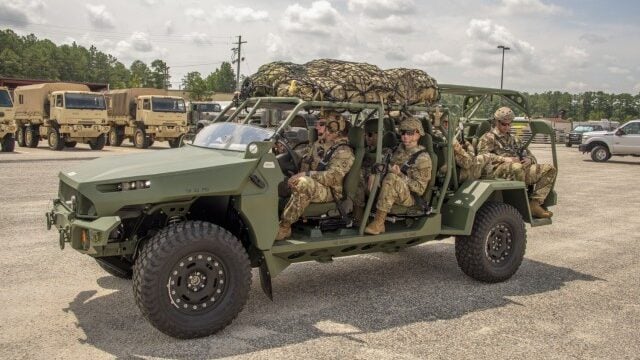
Paratroopers prepare to depart for a 50-kilometer road test in a fully loaded ISV after modifying airdrop rigging techniques because of structural and mechanical changes. (Army/Michael Zigmond)
WASHINGTON — The US Army is on the hunt for an already-in-production armor busting missile that it can quickly field to infantry soldiers on the move in smaller, lighter vehicles, according to a new notice.
Service officials unveiled the new Mobile-Long Range Precision Strike Missile (M-LRPSM) directed requirement in a request for information published on Wednesday, noting it needs industry to propose “readily available” weapons that can “bridge a current gap/operational requirement.”
More specifically, they want to provide the missile to Infantry Brigade Combat Teams for soldiers to use from their Joint Light Tactical Vehicles (JLTVs) or Infantry Squad Vehicles (ISVs). The missile needs to be able to hit armored vehicles, field fortifications and urban structures at least 25 kilometers away, and have the ability to “adjust missile flight, retarget, and abort.”
“[The missile] should be survivable and resilient in denied, degraded, intermittent, and limited-bandwidth (DDIL) environments, enabling the system to operate and protect itself against attacks on embedded network, cyberspace, electromagnetic spectrum (EMS), and position, navigation, and timing (PNT) capabilities,” the Army wrote.
“A time to target requirement is currently undefined however a reduced time of flight will be a key consideration,” it added. The service did not disclose when it wants to begin fielding the weapon to soldiers but said it considers this an “immediate capability.”
While the service does not outline firm launcher requirements, it notes that it should be able to hold at least four missiles.
Industry now has until Nov. 17 to respond to the Army’s request and provide additional details about their proposed missile.
Although the service does not detail specific weapons or companies it is eyeing for this effort, one prime candidate could be the Spike Non-Line-Of-Sight (NLOS) missile system, which can be fired from a four- pod launcher and is designed to penetrate armored targets up to 32 km away.
Offered inside the US via a teaming agreement between Lockheed Martin and Rafael Advanced Defense Systems, both the Army and special forces community have experience integrating Spike NLOS onto helicopters and ground vehicles.
Up in the air, the Army is using the weapon as its interim long-range precision munition for the AH-64 Apache helicopter, while US Special Operations Command has already tasked the industry partners with integrating the four-pod launcher on JLTVs.
In May 2022, Lockheed Martin officials told Breaking Defense that they can integrate the launcher onto vehicles smaller than the JLTV, potentially making the ISV an option too.
“If you have the bed-mounted rails on your vehicle, we designed our palletized launcher to readily adapt onto any vehicle that has that … kit on it,” Tom Bargnesi, precision strike program manager at Lockheed, told Breaking Defense at the time. “We actually demonstrated that, across a number of different vehicles in a very short amount of time, we were able to move our palletized launcher unit from a JLTV onto another vehicle onto another vehicle.”
Marines eye 2025 fielding of 3 new, mobile air defense systems
“We are on track from a programmatic standpoint — cost, schedule performance — but we’re always gonna be late to need,” said Col. Andrew Konicki, the program manager for Ground Based Air Defense (GBAD). “The threat is ever changing and ever evolving.”


























